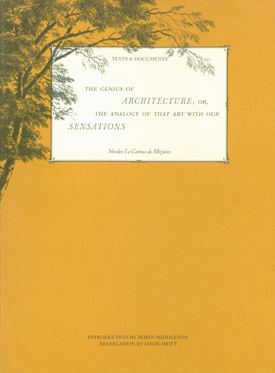
The Genius of Architecture; or, The Analogy of That Art with Our Sensations
Nicolas Le Camus de Mézières
Introduction by Robin Middleton; Translation by David Britt
1992
224 pages
PDF file size: 36.1 MB
Description
Nicolas Le Camus de Mézières (1721–circa 1793) emerges today as one of the more fascinating and influential architects of the French Enlightenment. Much admired by his contemporaries for his large circular market, the Halle au Blé (1763–67), Le Camus made his very significant mark on French Neoclassical theory with his fanciful and quixotic study The Genius of Architecture; or, The Analogy of That Art with Our Sensations (1780). In part a handbook on the planning of the French hôtel, in part a sensationalist exploration of form and its sentimental or expressive value—Le Camus’s always discreet and politic analysis argues the point that architecture should please the senses as well as the mind. Not only did such a proposition bring to a conclusion the theories of planning and caractère put forward by Germain Boffrand and Jacques-François Blondel, it also supplied the theoretical underpinning for the formal explorations of Etienne-Louis Boullée, Claude-Nicolas Ledoux, and John Soane. These issues and others are considered in the masterly and informative introduction by Professor Robin Middleton, which traces the theoretical development of such ideas through classical times and the eighteenth-century theories of Jean-Louis de Cordemoy, Jean-Baptiste Dubos, Roger de Piles, Etienne Bonnot de Condillac, Claude-Henri Watelet, Thomas Whateley, and Jean-Marie Morel.
The Texts & Documents series offers to the student of art, architecture, and aesthetics neglected, forgotten, or unavailable writings in English translation.
Edited according to modern standards of scholarship and framed by critical introductions and commentaries, these volumes gradually mine the past centuries for studies that retain their significance in our understanding of art and of the issues surrounding its production, reception, and interpretation.
Eminent scholars assist in the selection and publication of volumes in the Texts & Documents series. Each volume acquaints readers with the broader cultural conditions at the genesis of the text and equips them with the needed apparatus for its study. Over time the series will greatly expand our horizon and deepen our understanding of critical thinking on art.
Table of Contents
- Acknowledgments
- Translator’s Note
David Britt - Introduction
Robin Middleton - The Genius of Architecture; or, The Analogy of That Art with Our Sensations
Nicolas Le Camus de Mézières- Introduction
- The Genius of Architecture
- Orders of Architecture
- Pedestal
- Column
- Entablature
- Tuscan Order
- Doric Order
- Ionic Order
- Corinthian Order
- Composite Order
- he Idea of a French Order
- Orders of Architecture
- On the Art of Pleasing in Architecture
- Exterior Decoration
- On Distribution and Decoration
- Vestibule
- First Anteroom
- Second Anteroom
- Third Anteroom
- Salon
- Bedchamber
- Boudoir
- Looking Glasses
- Dressing Room
- Closet for Clothing
- Closet of Ease
- Water Closet
- Baths
- Anteroom to the Baths
- Bathroom
- Vapor Bath
- Bedroom Adjacent to the Bath
- Closet for the Bath
- Closet of Ease
- Linen Room
- Cabinets
- Grand Cabinet or Study
- Back Cabinet or Private Study
- Repository for Papers
- Closet of Ease
- Lobby
- Library
- Cabinet Adjacent to the Library
- Cabinet of Medals and Antiquities
- Cabinet of Natural History
- Cabinet of Machines
- Dining Room
- Serving Room
- Kitchens and Offices
- Kitchen
- Larder
- Fish Larder
- Wood Cellar
- Roasting Chamber
- Pastry Kitchen
- cullery
- Servants’ Hall
- Kitchen Yard
- Offices or Pantries
- First Pantry Room
- Second Room, Workroom for Confectionery
- Third Room, for Preparing the Desserts
- Fourth Room, Storeroom for Confectionery
- Fifth Room, Used as a Fruitery
- Sixth Room, for Trays and Porcelain
- Seventh Room, for the Silver
- Eighth Room, for the Pantryman’s Lodging
- Ninth Room, for the Under Pantryman
- Lodging for the Majordomo
- Lodging for the Head Cook
- Lodgings of the Various Officers
- Secretary’s Apartment
- Under Secretary’s Lodging
- Librarian
- Lodging of the Children of the House
- Lodging of the Sons of the House
- Young Ladies’ Lodging
- Steward’s Lodging
- Lodgings of the Valets de Chambre
- First Valet
- Second Valet
- First Lady’s-Maid
- Second Lady’s-Maid
- Linen Room
- Housekeeper’s Lodging
- Infirmary
- Stable Yards
- Of Stables and Carriage Houses
- Stables
- Stables for Saddle Horses
- Stables for Visitors’ Horses
- Carriage Houses
- Harness Room
- Saddle Room
- Dung Yard
- Farrier
- Lofts for Hay
- Lofts for Straw
- Lofts for Oats
- Lodging of the Head Groom
- Under Groom
- Upholsterer
- Depository for Furniture
- Riding School
- Appendix A
- Appendix B
- List of Nicolas Le Camus de Mézières’s Publications
- Index
About the Authors
Robin Middleton is an architect; technical editor of Architectural Design; consultant to Thames & Hudson, Cambridge University Press, and Daidalos; and a faculty member at the University of Cambridge, the Architectural Association, Bartlett School of Architecture, and Columbia University.
David Britt was an editor of art books at Thames & Hudson in London for more than twenty years; since 1987 he has been translating full-time. His translations in the Getty Research Institute’s Texts & Documents series include titles by Aby Warburg, Friedrich Gilly, and Nicolas Le Camus de Mézières.